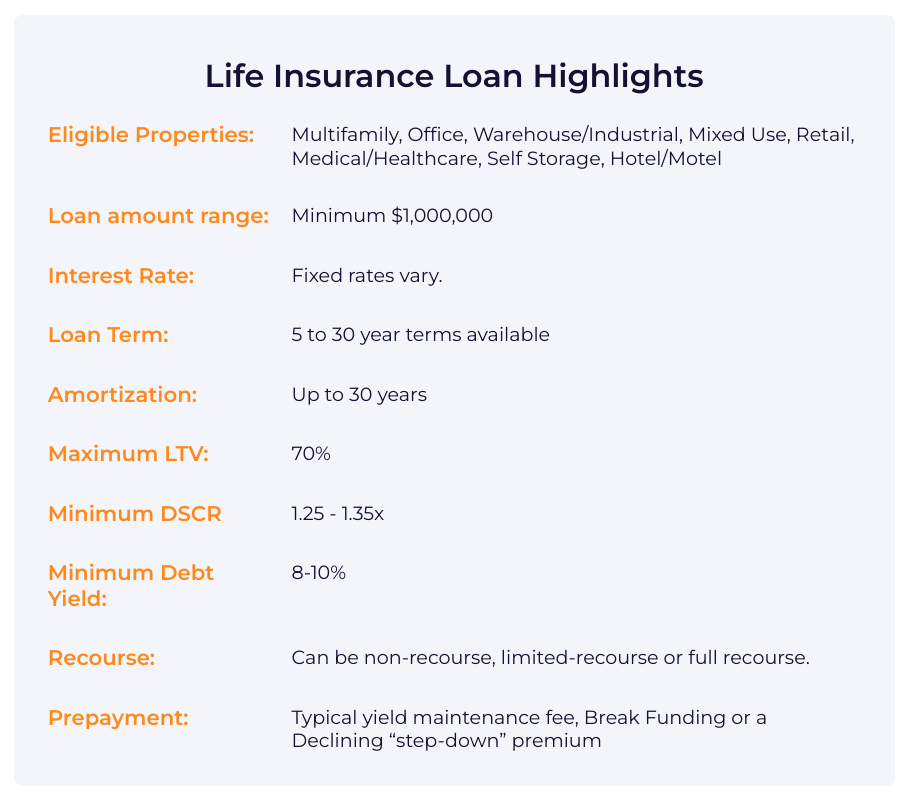Life insurance loans can fund various multifamily investments, but usually require top condition properties. These loans are typically for Grade A properties with low LTV and high DSCR.
Many life insurance companies underwrite commercial real estate loans, either individually or in cooperation with other life insurance providers. The purpose of these loans is to provide the life insurance company with some returns, while significantly mitigating their risk exposure through diversification. That purpose or risk mitigation is the underlying factor in virtually all aspects of these loans.
If you are looking for a long-term and low-rate commercial real estate loan, a life insurance company might have the right financing for your project.


Life Insurance Commercial Loans FAQ’s
What Are Life Insurance Company Commercial Real Estate Loans?
Life insurance company commercial real estate loans are commercial mortgages underwritten by life insurance companies. Borrowers rarely interface with the life insurance company directly, but rather go through an intermediary who arranges the loan with one or more life insurance companies. It’s the life insurance provider that ultimately underwrites these loans, however.
When underwriting these loans, life insurance companies look to take on as little risk of default as possible.
What Commercial Properties is Life Companies Real Estate Lending Well-Suited For?
Because life insurance companies are using these loans largely to reduce risk, they aren’t keen on underwriting distressed properties.
Most life insurers stick to Class A properties that are newer, and therefore in generally good condition. They may finance apartment complexes, retail centers, office buildings and industrial parks, and some will also underwrite loans for top-tier hospitality properties.
For example, life insurance company lending might be used to finance:
- Mixed-use apartment complex near the campus of a college town
- Anchored shopping center that has an established sales history
- Large office building located in the downtown of a major city
- Warehouse at a major regional or national distribution hub
- High-end national hotel chain resort in a major tourist area
Additionally, properties usually have to be newer and located in major real estate markets. Life insurers want new properties because they tend to be in better condition, which is especially important when underwriting loans with long terms (see below). Most companies will entertain properties in primary or secondary markets, but some life insurers only offer loans in primary ones.
In relatively uncommon cases, life insurance companies will underwrite commercial construction loans. These are typically only available for truly singular properties, however.
What Are the Underwriting Requirements for Life Insurance Company Commercial Real Estate Loans?
The terms that life insurance companies set forth are some of the most conservative in commercial real estate lending. Again, this stems from their desire to mitigate risk with these products.
Underwriting Requirements for Life Insurance Real Estate Loans
The underwriting requirements typically state a maximum loan to value ratio (LTV) of around 65%, although some will vary in either direction by up to 10%. LTVs above 75% are virtually unheard of, and even attaining that LTV is only possible if a borrower and property are both pristine.
Most life insurers weigh the debt service coverage ratio (DSCR) especially heavily. The minimum accepted DSCR is typically 1.25, and higher is preferred. Moreover, this ratio must be calculated using current income rather than projected future income.
Duration and Interest Rates for Life Insurance Real Estate Loans
For borrowers that can meet these stringent requirements of life insurance real estate loans, these offer long terms with low interest rates.
Whereas banks frequently focus on shorter-term loans that provide quicker returns, life insurance companies are again more interested in risk mitigation. This not only allows them to offer terms that are longer than average, but they even prefer the longer durations. Many of these loans have 15, 20 or 30 year terms, and can be amortized over 30 years.
Interest rates are frequently fixed for the entire duration of these loans. Although the interest rates can be higher than short-term adjustable loans offer, life insurance real estate loans usually have some of the lowest multi-decade rates available.
Most loans require borrowers to finance at least $1 million, and many have a $2 million minimum requirement. The upper end of what can be financed is an open question that can be discussed when seeking life companies real estate lending for high-value properties.
What Features Do Life Insurance Commercial Real Estate Loans Come With?
Life insurance commercial real estate loans have several features that make them well-suited for newer properties that need longer loans. Some of the more notable features are as follows.
Recourse: Life insurance loans aren’t obligated to have any specific recourse feature. They can be full recourse, limited recourse or non-recourse loans.
Non-recourse loans generally don’t hold individual borrowers responsible in the event of a default. The collateral property and its cash flows are all that the life insurer can go after. Limited recourse makes individual borrowers responsible for a percent of the amount borrowed, and full recourse makes them responsible for the entire amount borrowed.
Limited recourse and non-recourse have standard carve-outs for certain dishonest acts. For instance, borrowers might be held financially liable if they act fraudulently.
Assumption: Most life insurance loans are assumable, which means that they can be transferred to another qualified borrower without refinancing the property.
Property investors should remember that any purchaser who intends to assume this type of loan will likewise have to meet the loan’s strict credit and other underwriting requirements. A fee is normally charged when transferring any commercial real estate loan.
Prepayment Penalty: Life insurance loans can have fairly substantial prepayment penalties, for these loans are intended to be used for longer-term financing.
A loan’s prepayment penalty might be structured as yield maintenance (borrows must maintain the same yield), break funding (borrowers must compensate so that the lender doesn’t incur a loss) or step-down (percentage-based penalty decreases at set durations, usually over 5 or 10 years).

